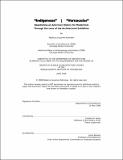"Indigenous" -- "Vernacular" : negotiating an American history for modernism through the lens of the architectural exhibition
Author(s)
Rahmlow, Rebecca Suzanne
DownloadFull printable version (56.46Mb)
Alternative title
Negotiating an American history for modernism through the lens of the architectural exhibition
Other Contributors
Massachusetts Institute of Technology. Dept. of Architecture.
Advisor
Caroline A. Jones.
Terms of use
Metadata
Show full item recordAbstract
After modernism was conceptualized as the "International Style" at the Museum of Modern Art in 1932, historians and critics sought to legitimate American architecture through the construction of a linear ancestry which placed the beginnings of modernism in the nineteenth century, on American soil. Victorian-era revivalism complicated this thread, but it also served as the impetus for a revision of history. The possibilities of interpretation offered by the architectural exhibition, and its key evidence, the photograph, were critical to this endeavor. It is my contention that having first established modernism as the "International Style" and second, located its history in select architectural monuments of the nineteenth and early twentieth centuries, architectural historians and critics spent the remainder of the 1930s deemphasizing European influences by crafting an American heritage for modernism. While modernists initially chose to ignore this revival style architecture, their proliferation, popular appeal, and seeming discrepancies with the present, both socially and formally, inspired two exhibitions which examined these buildings more critically. Lincoln Kirstein employed the term "indigenous" with regard to his 1933 MoMA exhibition, Walker Evans: 19th Century Houses, in order to distance, but not disavow Victorian-era domesticity and society. Conversely, Henry-Russell Hitchcock utilized "vernacular" in his 1934 exhibition at Yale University, The Urban Vernacular of the Thirties, Forties, and Fifties: American Cities Before the Civil War, to establish a formal continuity between Greek Revival antebellum urban architecture and 1930s modernism. In part a reaction to Kirstein's claims, Henry-Russell Hitchcock produced a selective "vernacular" which made the nineteenth century past accessible as a functional precedent for modernist designers. (cont.) This thesis explores the construction, and the impact of these two efforts, which coded revivalism as something "native" to America in order to negotiate a relationship between the modernist present and its seemingly incompatible past.
Description
Thesis (S.M.)--Massachusetts Institute of Technology, Dept. of Architecture, 2008. This electronic version was submitted by the student author. The certified thesis is available in the Institute Archives and Special Collections. Includes bibliographical references (p. 183-189).
Date issued
2008Department
Massachusetts Institute of Technology. Department of ArchitecturePublisher
Massachusetts Institute of Technology
Keywords
Architecture.